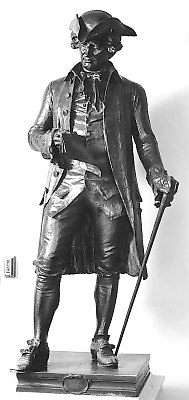
The following query has been posted by both American and Swedish researchers in various types of media, including Anbytarforum, the query section of the e-zine Rötter (www.genealogi.se), a web site maintained by Sveriges Släktforskarförbund (the Federation of Swedish Genealogical Societies):
I am looking for information about Colonel John Hansson, who was married to Margareta Vasa, grandchild of Gustaf Vasa, founder of the Royal House of Vasa. They lived in the early 1600s. John was in the Swedish Army and died during the battle at Lützen in 1632. He had four sons who came to Fort Christina in Delaware to establish a Swedish colony at the request of the Queen. One of the four brothers had a son, John Hanson, who became the first president of the Continental Congress in the U.S. in 1782.
There are variations to the query, some including more generations between the brothers who emigrated and the politician John Hanson from Charles County, Maryland.

But this is not how it was. Colonel John Hansson was not married to Margareta Vasa, he did not die during the battle at Lützen, and it seems he did not even exist. Nor has it been found that four Hansson brothers came to New Sweden; or that any of these non-existing brothers became the grandfather of John Hanson, President of the Continental Congress.
It is a human tendency to embellish one's ancestry a little bit, and this is a good example. There is among my own female ancestors a woman by the name of Stina Pettersdotter. However, upon her death in 1913, she was registered as "the widow Christina Svensson," which the survivors probably thought more impressive.
The story attracted attention and Amandus Johnson, the industrious founder of the American Swedish Museum in Philadelphia, made sure that John Hanson's memory was kept alive at Gloria Dei. Because of this, the story about the illustrious colonel received its place in the Swedish-American tradition and contributed to many peoples' pride in Sweden's small contribution to the he United States.
Still, Sten Carlsson agrees that the name appears to be Swedish, even if the tradition also mentions British origins going all the way back to Yorkshire during the 1200s. The baptismal names point to England and, according to George A. Hanson, the Swedish contribution to the family stems from a John Hanson of London marrying a Swedish woman during a summer trip in the late 1500s who had close connections, but no family ties with the royal family. Both husband and wife supposedly died young, but left a son, the future colonel. He was about the same age as Gustaf II Adolf who was born 1594. The son is said to have been brought up at the court and then made his career in the military. One problem with this theory is that a colonel by this name has not been found in the Swedish Army during the time in question (i.e., before 1632).
It was not George A. Hanson who brought up the theory of John Hanson's wife being a Vasa descendent, but later enthusiasts, who obviously were easily proven wrong. The story about how the young brothers Hanson had been encouraged by sixteen-year-old Queen Kristina to emigrate in 1642 also seems rather unlikely. Sten Carlsson seems to accept that the colonel had the four above-mentioned sons and that they were born in Sweden, traveled to New Sweden, and later settled in Maryland.
In October 1988, George Ely Russel, a very well-known American researcher, published an article called "John Hanson of Maryland, A Swedish Heritage Disproved" in The American Genealogist (Vol. 63:4). Mr. Russel checked the sources for information and found that John Hanson (the emigrant) lived in Maryland in 1662, when he changed jobs. He was a so-called indentured servant, which does not exactly mean that he lived in serfdom, but was bound by contract to the farm owner. His first master was William Plumley from Barbados. In 1661 John's contract was sold to Edward Keene of Calvert County, Maryland, who had come from England in 1653. He in turn sold it to John Geere. John Hanson later became the owner of a small farm.
John Hanson's (the emigrant) only known wife was Mary, last name unknown. Their children's names were Robert, Benjamin, Mary, Anne, Sarah, John, and Samuel. All of them married people with typical British names. The Swedes in the area typically married other Swedes, which is often obvious by the naming custom. Also, the sources show that John Hanson never was in contact with another Swede and did not live in an area inhabited by Swedes. Furthermore, it does not seem that he had any contact at all with his alleged brother, Anders Hansson, of Beaver Neck, Kent County, Maryland.
Anders Hansson and other Swedes who settled in this area left numerous documents that have been published by Amandus Johnson in Swedish Settlements on the Delaware 1638-1644 (1911). John Hanson is not to be found here. No naturalization documents, which would have been absolutely necessary in order for him to become a British citizen and own land in Maryland, have been found. It is a fact that he owned land in Maryland, which he willed away at his death in 1713. His possible "higher" status as the grandson of a royal descendent is never mentioned in Maryland; he is never called esquire or gentleman.
Dr. Craig further contends that there was only one John Hanson in New Sweden, a boy born in 1655 to Hans Månsson and Ella Stille. He later called himself John Hans Steelman and became a well-known businessman and interpreter among the Indians in northern Maryland in the late 1600s.
So the story about the United States' first president, before George Washington, being of Swedish descent can now be relegated to the bottom of the myths.
This article was first published in the Swedish American Genealogist, June 2001, vol.XXI:2, and the Släkthistoriskt Forum 2000:4.
Uppdaterad 22 December 2005
© Elisabeth Thorsell